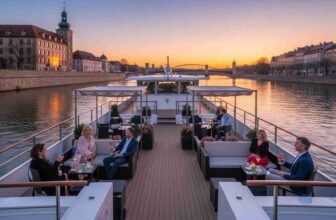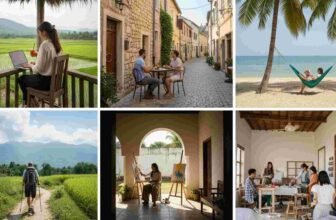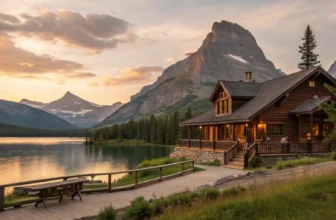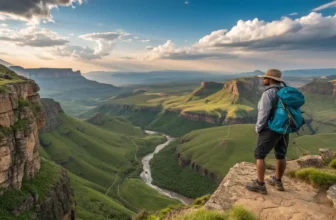

First came the sound—a train horn fading into pine-scented air—then hush of a main street where neon hums and stars feel close enough to pocket. We’re all chasing that spark right now: wonder without the crowds, discovery that still feels like yours. With prices soaring and big destinations bursting at the seams, small-town adventures are the smarter bet—and richer story.
Ahead, you’ll meet places shaped by craft, community, and landscapes that tug at your ribcage. Come ready for slow mornings, porch-light conversations, and nights that end under impossible skies. I’ll show you where to look—and how to do it right.
1. Marfa, Texas

Marfa. In far-west Texas, tucked into the high desert of the Trans-Pecos region (elevation ~ 4,685 ft) and the county seat of Presidio County. This place feels like the wide open sky—art galleries dot an Old-West-style town, there’s only one traffic light (yes, really) and you’ll find the clear darkness of a night sky as good as any remote spot in America.
the town’s population as of the 2020 Census is just 1,788. So yes, “hidden gem” is accurate. Because of its remote location, reaching Marfa takes some planning. But that remoteness is part of what gives it charm. The art scene here is noteworthy—think world-class installations and a vibrant cultural undercurrent.
Practical Information:
- Best seasons/Weather: The high desert means big skies, warm days, cool nights. If you go in summer, prepare for heat; spring or fall might be more comfortable.
- How to reach & explore: You’ll likely drive in (from regional airports). Once there, you can simply stroll downtown, visit art installations and take in the desert landscape.
- Ideal visit duration: 2–3 nights gives you time to soak in the art + landscape + night sky.
- Must-try experience: Visit galleries, check out the minimalist art legacy, stay until dusk for stargazing. Also drive out toward the surrounding desert and ranchland.
- Budget notes: As a small town, costs for lodging might vary significantly; since it’s become more popular you might find boutique options.
- Photography moments: Sunset in the desert, night sky exposures, the contrast of old-West buildings + modern art.
- Cultural note: It’s remote and the vibe is relaxed. Don’t expect big-city bustle; instead, embrace the slower pace.
2. Hood River, Oregon

Hood River sits where the Columbia River Gorge meets the Cascade Range. That geography gives it big views and big opportunities. The town has earned a reputation for all kinds of outdoor action—windsurfing, kite-boarding, mountain biking—and also for strong food and drink culture (wineries, craft brews).
As of 2023, Hood River County’s population is just over ~23,745. The history of the area is interesting too: apple orchards dominated around 1890-1920, and later pears became a major crop. So while it’s now an outdoor/adventure hub, it has agricultural roots.
Practical Information:
- Best seasons/Weather: Summer is great for windsports; autumn brings beautiful foliage. Winters bring snow in the higher elevations nearby though the town itself is milder.
- How to reach & explore: Easy drive from Portland or along I-84 through the Gorge. Once there, take advantage of riverside trails, go or across the trail network, check out wineries & orchard tours.
- Ideal visit duration: 2–4 days to mix adventure + relaxation + culinary stops.
- Must-try experience: Jump into the “wind sport mecca” vibe—either watching or trying windsurf/kite on the Columbia, then shift gears into tasting local wines or craft beers.
- Budget notes: Accessible for mid-range budgets; some outdoor gear rental may cost extra. Lodging in peak seasons (especially summer) can climb.
- Photography moments: Early morning mist over the river, kite sails against cliff backdrop, orchard rows in bloom.
- Cultural note: The outdoors-community vibe is strong; you’ll find active folks, good cafés and relaxed but vibrant local flavor.
3. Stowe, Vermont

Stowe is a four-season destination in Vermont, nestled at the foot of Mt. Mansfield (the state’s highest peak). The 2020 population: 5,223. For those who like skiing, it’s long been known as one of the east’s premier ski towns; but if you go outside of winter it’s still vibrant—hiking, scenic views, local flavor.
you get that classic New England mountain-town feel (Chalet-style lodges, winding roads) but also modern amenities and a pretty solid visitor infrastructure. History runs deep too—chartered in 1763.
Practical Information:
- Best seasons/Weather: Winter for snow, spring and summer for green landscapes & hiking, autumn for foliage.
- How to reach & explore: Drive in (closest major airports are a bit away). Rent a car to explore trails, town, mountain peaks.
- Ideal visit duration: 3–5 days allows you to hit a trail, one big view, and relax in town.
- Must-try experience: Skiing or snowboarding (if winter); in summer go for a scenic hike or ride; stroll the town center, sample local craft beers and Vermont-style food.
- Budget notes: Popular resort town—peak seasons (winter, fall foliage) will cost more. Off-season may be a good deal.
- Photography moments: Snow-covered lodge, mountain vistas, crisp autumn leaves.
- Cultural note: New England politeness, small-town charm, but with enough amenities to feel comfortable.
4. Eureka Springs, Arkansas

This one is a bit off the beaten path—but that’s exactly the appeal. Eureka Springs is located in the Ozark Mountains of NW Arkansas, near the Missouri border. In 2020 its population was 2,166.
The town is built on steep terrain, streets that wind up and down (they call it the “Stairstep Town”). Its origins are tied to mineral springs—people believed in their healing powers, and by the late 19th century it was a resort destination.
Practical Information:
- Best seasons/Weather: Mild/four-season climate (average high ~71°F, low ~46°F) with about 36 in of rain annually. Fall colors can be spectacular in the hills.
- How to reach & explore: You’ll drive in; once there, get ready to walk the hills or use local transport (some steeper spots). The downtown area is compact so walking works well.
- Ideal visit duration: 1–2 nights can give you a good feel; 3 nights lets you explore more deeply.
- Must-try experience: Walk the historic downtown, stay in a Victorian cottage, explore the local springs (even if just historically), take scenic drives around the Ozarks.
- Budget notes: Smaller resort town so lodging and meals may be more affordable than major tourist hubs—but check summer/event peaks.
- Photography moments: Victorian architecture on slopes, winding streets, hillside views in autumn.
- Cultural note: Quirky, historic, relaxed. Some businesses may have odd hours (worth checking ahead).
5. Bisbee, Arizona

Bisbee is a former mining town in southeastern Arizona (Cochise County) with a 2020 population of 4,923. The mining history runs deep: over its heyday, the area produced ~8 billion lbs of copper, ~102 million oz of silver and ~2.8 million oz of gold.
Today, it stands out because of its quirky, artsy vibe, historic architecture, and hillsides stacked with colorful houses. The “Queen of the Copper Camps” nickname speaks to its legacy.
Practical Information:
- Best seasons/Weather: Southeastern Arizona means low rainfall, generally mild—though summer may be hot.
- How to reach & explore: Drive in from Arizona highways; once there, the downtown is very walkable. Consider taking a guided mining tour (for the history plus cool underground).
- Ideal visit duration: 1–2 nights are enough for the core experience; 3 nights if you want to slow down and soak the art scene.
- Must-try experience: Take the mining history tour, browse vintage shops (mineral/gem stores), catch the arts scene and quirky local events (like the stairs race) that make Bisbee feel unique.
- Budget notes: Smaller town, so more modest budgets can work well; check lodging deals especially off-peak.
- Photography moments: Colorful homes up the hill, historic mining infrastructure, dramatic shade vs desert light.
- Cultural note: Embrace the quirky. Bisbee has strong character; the locals are used to visitors but the vibe stays authentic.
6. Bozeman, Montana

You get Rockies energy with college-town curiosity. Morning coffee turns into a trail plan; dinner turns into a live-music detour. Bozeman’s draw isn’t subtle—Yellowstone is a half-day away, and the region’s busiest airport (BZN) sits just 8 miles from town, which is why it’s become the state’s travel hub.
growth. A lot of it. Think new hotels, polished dining, and a creative scene that feels bigger than a city of roughly 55,000—with locals jokingly calling it “Boze-Angeles.” That boom brings amenities (rooftop pools, mural-lined alleys), along with higher prices and a conversation about how to grow without losing the soul. Good to know if you’re budgeting.
Practical Information:
- Peak Season: June–August (summer activities); December–February (ski season)
- Off-Peak: April–May, Sept–Oct (fewer crowds, lower prices)
- Nearest Airport: Bozeman Yellowstone Intl. Airport (BZN) – 8 miles from town
- Ideal Stay: 3–4 days
- Must-Do: Museum of the Rockies, Hyalite Canyon, Downtown Main Street
- Budget Range: Mid–high (boutique hotels and dining have surged)
- Local Tip: Early morning hikes = fewer crowds and best light for photography
7. Leavenworth, Washington

Leavenworth’s magic lies in its commitment to the bit. This once-declining timber town reinvented itself as a Bavarian village, complete with alpine façades, bratwurst stands, and Christmas lights that would make the North Pole jealous. It could’ve been gimmicky—but it works because it’s backed by genuine community spirit and jaw-dropping mountain scenery.
lederhosen in summer heat, snow-dusted carolers in winter. The annual Village of Lights festival transforms it into one of the most photographed small towns in America. But venture just outside, and you’ll find real alpine adventure—Colchuck Lake, Icicle Ridge, and whitewater rafting along the Wenatchee River.
Practical Information:
- Peak Season: December (Christmas lights) & July–Aug (summer events)
- Off-Peak: April–May, Sept (mild weather, cheaper rooms)
- How to Reach: 2.5-hour drive from Seattle via U.S. Route 2
- Ideal Stay: 2–3 nights
- Must-Do: Nutcracker Museum, Icicle Creek trails, Oktoberfest celebration
- Budget Range: Moderate; higher in holiday season
- Photography Tip: Shoot village rooftops at sunset from Waterfront Park footbridge
8. Beaufort, South Carolina

Beaufort feels like a film set—and in many ways, it is. Dozens of productions have used its oak-lined streets and antebellum homes, but the town’s soul goes beyond its cinematic looks. Nestled on Port Royal Island, Beaufort’s blend of Gullah-Geechee heritage, coastal cuisine, and 300-year-old architecture makes it one of the most culturally rich small towns in the South.
The Beaufort Historic District, covering 304 acres, features more than 70 properties listed on the National Register of Historic Places. Stroll down Bay Street for handmade crafts and southern seafood (shrimp and grits, anyone?), then unwind under Spanish moss at the waterfront park.
Practical Information:
- Peak Season: March–May & Sept–Nov (pleasant temps, fewer bugs)
- Off-Peak: Mid-summer (humid), winter (quiet, lower rates)
- Nearest Airports: Savannah/Hilton Head (1 hr), Charleston (1.5 hrs)
- Ideal Stay: 2–3 days
- Must-Do: Hunting Island Lighthouse, Verdier House Museum, Gullah tours
- Budget Range: Mid-range; charming inns & historic B&Bs
- Local Tip: Early mornings bring magical mist along the tidal creeks—great for photography
9. Sedona, Arizona

Sedona isn’t just photogenic—it’s spiritually charged. Locals talk about energy vortexes, but even skeptics agree: something about those red rocks hits different. The colors shift hourly with the sun, and the trails around Cathedral Rock, Bell Rock, and Devil’s Bridge pull in hikers from around the world.
Beyond the scenery, Sedona has a thriving art and wellness scene. Crystal shops, yoga retreats, and desert galleries line State Route 179, nicknamed “The Red Rock Scenic Byway.” And while it’s small (around 10,000 people), it gets over 3 million visitors annually, so timing your visit makes all the difference.
Practical Information:
- Peak Season: Spring & Fall (mild weather, clear skies)
- Off-Peak: Summer (hot afternoons, fewer crowds)
- Nearest Airport: Phoenix Sky Harbor (2 hrs by car)
- Ideal Stay: 3–4 days
- Must-Do: Cathedral Rock, Tlaquepaque Arts Village, Sedona Vortex sites
- Budget Range: Mid–high (accommodation fills fast)
- Photography Tip: Sunset from Airport Mesa or sunrise from Doe Mountain
10. Galena, Illinois

Tucked in the northwest corner of Illinois, Galena feels frozen in time—in the best way. Nearly 85% of its buildings are part of the Galena Historic District, with 19th-century brick storefronts, wrought-iron balconies, and cobblestone streets still intact. It’s both an architectural treasure and a cozy Midwest getaway.
Once a booming lead-mining hub and home to Ulysses S. Grant, Galena has reinvented itself as a weekend haven filled with boutique shops, vineyards, and river views. The town draws over a million visitors yearly but somehow keeps that small-town ease alive.
Practical Information:
- Peak Season: May–Oct (warm, perfect for walking tours)
- Off-Peak: Nov–Mar (holiday charm, cheaper stays)
- How to Reach: 3-hour drive from Chicago or 2 hours from Madison
- Ideal Stay: 2–3 days
- Must-Do: Grant Home Museum, Galena Cellars Vineyard, Main Street stroll
- Budget Range: Moderate; great mix of B&Bs and boutique hotels
- Photography Tip: Early morning fog over the river and twilight shots on Bench Street
11. Bayfield, Wisconsin

Tucked at the edge of Lake Superior, Bayfield, Wisconsin is tiny (population ~ 584 in 2020) yet full of surprises. The “gateway” to the Apostle Islands National Lakeshore, it pairs rugged wilderness with orchard-country charm—and that mix turns up in unexpected delights. One moment you’re browsing a gallery, the next kayaking sea caves.
Visit outside peak summer and you’ll find the harbor docks quiet, the breeze crisp, and the scent of apple orchards more present than the tourist buzz. In October the town’s Apple Fest draws about 60,000 people—but if you go just before or after, you get the charm without the crowds.
Practical Information:
- Best time: Late September – early October for apple-harvest atmosphere; also May–June for fewer crowds.
- How to reach: Drive via Hwy 13 from Ashland (WI) or Duluth (MN); ferry for island tours.
- Ideal stay: 2 nights to cover orchard country, lakeshore and village.
- Budget tier: Modest; lodging is small-town priced but summer rises swiftly.
- Don’t miss: Sea-cave kayak trip, local cider tasting at a family orchard.
12. Ithaca, New York

Most people think “college town” and “waterfalls” separately—but here they merge. You can hike past Buttermilk Falls in the morning, then sip craft cider near Cornell in the afternoon. Multitask scenery + culture.In the heart of the Finger Lakes, Ithaca, New York has university-town energy, dramatic gorges and waterfall-rich terrain. Named by CNN Travel as the “Best Town to Visit in 2025.”
Stay off East Hill for cheaper lodging; walk downtown to the pedestrian mall (The Commons) and find living-room-style cafés. Early fall gives peak leaf colour + decent hotels before peak rates.
Practical Information:
- Best time: Mid-September (leaf blush) or late-spring (water high).
- Arrival: Ithaca Tompkins Int’l Airport; or drive via NY-79/96.
- Ideal stay: 2–3 days.
- Budget tier: Moderate—lodging deals abound outside college move-in/out.
- Don’t miss: Gorge Trail loop, farmer’s-market lunch, a vino stop on Cayuga Lake.
13. Traverse City, Michigan

The lakeside hub in northern Michigan quietly hits a lot of marks: wine-country, lake views, serious food culture.Beyond cherry festivals and beaches, dive into the “Terroir Trail”—more than 50 wineries/spaces along the Leelanau & Old Mission peninsulas. Cherry orchards and vineyards side by side.
Book a room in Traverse City proper, but schedule one full day for a “peninsula loop” drive: vineyards, beach stop, historic lighthouse. Spring before the crowds = best value.
Practical Information:
- Best time: Late May (wine events) or early October (autumn colour + fewer tourists).
- How to reach: Cherry Capital Airport (TVC) plus rental; or drive from Grand Rapids.
- Ideal stay: 3 nights (town + wineries + beach).
- Budget tier: Mid to high in summer; shoulder seasons friendlier.
- Don’t miss: Glass-bottom boat ride, lake-front boardwalk evening stroll, cherry-pie dessert.
14. Kennebunkport, Maine
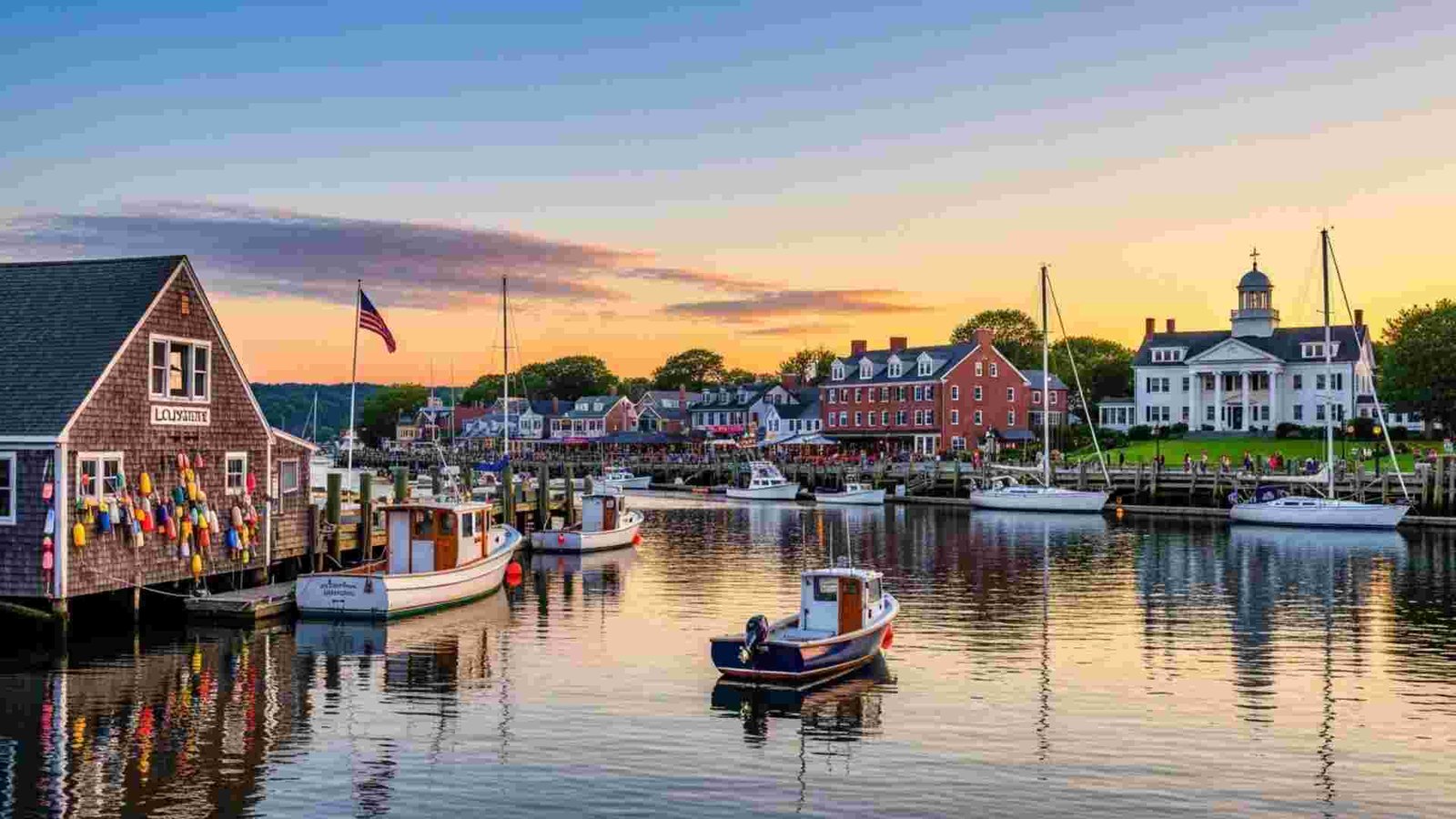
On the rocky southern Maine coast, Kennebunkport, Maine blends seaside elegance and historic roots. Population ~ 3,629 in 2020.Skip the summer hordes and go spring or late fall—Cape Porpoise near the edge is quiet, working-fishing-village flavour still strong. Surfside cafés overlook the harbour; you’ll find lobsters but fewer selfie-spots.
Time your walk early down Dock Square (pre-breakfast) to scout sea-stacks with just locals and seabirds. For budget-minded: share a cottage off main street rather than boutique hotel.
Practical Information:
- Best time: Late April–May or October.
- Arrival: Portland Jetport ~40 min drive; drive US-1 for scenic route.
- Ideal stay: 2 nights (day 1 village & harbour; day 2 coast & beach).
- Budget tier: Moderate–high (coastal resort town).
- Don’t miss: Walk the Marginal Way, sunset from Goose Rocks Beach, seafood shack lunch.
15. Eureka, California

On the rugged northern California coast, Eureka, California is often overshadowed by Mendocino and Humboldt but holds serious character: Victorian architecture, redwood backdrop, and logging/maritime roots.
It’s a staging ground for redwood forest adventures (think giant trees, fog-lit forest floor) but also has an art-deco downtown that seldom makes the coastal zip-line lists. Stay in a historic “Painted Lady” suite and wake to seal-puppy calls from the bay.
Practical Information:
- Best time: March–April (mild, flowers) or Oct–Nov (storm vistas)
- Arrival: Drive US-101; nearest major airport is Redding or Eureka Airport (ACV)
- Ideal stay: 2 nights — downtown + coastal drive to Redwood National & State Parks
- Budget tier: Moderate; fewer crowds equals better value
- Don’t miss: Old Town waterfront, rainforest walk in Humboldt Redwoods, bay-front dining at dusk
16. Port Townsend, Washington

Nestled on the Quimper Peninsula at the northeast tip of the Olympic Peninsula, Port Townsend is a historic Victorian-era seaport known for its well-preserved architecture and maritime legacy. It has a population of around 10,148 according to the 2020 census.
It’s not just “old buildings” though — the downtown is a National Historic Landmark District, and the town’s arts community, independent shops, and waterfront trails give it a multi-layered appeal.
Practical Information:
- Best time to visit: Late spring (May–June) and early fall (September) tend to offer good weather, fewer crowds, and a relaxed pace. Summer is popular but can bring higher lodging rates.
- Getting there: It’s about a 2-hour drive from the Seattle metro area, depending on route and whether you take a ferry option.
- Ideal stay duration: 2–3 nights will allow you to explore downtown, a state park or two, and perhaps a trail or beach with time to unwind.
- Must-do experiences:
- Walk Water Street and the historic downtown waterfront.
- Visit Fort Worden State Park — beaches, bunkers, trails.
- Explore local galleries, the arts scene, and relaxed cafés.
- Budget considerations: Lodging can range from modest motels to boutique historic hotels; shoulder seasons may offer better value. According to a recent guide, hotel rates are often lower in September-November.
17. Fredericksburg, Texas

Beneath the tasting-room buzz, Fredericksburg is still a German-Hill-Country town with limestone bones and starry nights. The Texas Wine Country here exploded—from a handful of wineries decades ago to 80+ today—and the orbit includes Enchanted Rock, a pink-granite dome with sweeping Hill Country views. Book sunset; bring a headlamp for the hike down.
midweek after harvest. Tasting rooms slow down, winemakers chat longer, and you’ll actually hear the cicadas. The town’s rise brings crowds—and some growing pains—so travel smart: shuttles > car-hopping, and hydrate between pours.
Practical Information:
- Best window: March–May (wildflowers) & Oct–Nov (harvest air without peak heat).
- How to arrive: SAT or AUS → ~1.5–2 hrs by car.
- Stay length: 2 nights (wine trail + Enchanted Rock).
- Pro move: Reserve tastings; target early slots; plan a driver/shuttle.
- Budget watch: Weekends surge; midweek cottage stays are friendlier.
18. Taos, New Mexico

high-desert light, adobe walls, and an arts lineage that still feels restless. The UNESCO-listed Taos Pueblo—continuously inhabited for over 1,000 years—sets the tone: living culture, not a museum piece. Walk in quietly; you’re a guest first, a traveler second.
Step away from the plaza at sunrise. The Sangre de Cristo peaks blush pink while the town wakes slowly. Elevation sits around 6,970 ft, so the air’s thin and the light is razor-sharp—great for photos, tough on casual hikers. Pace yourself.
Practical Information:
- Best window: Sept–Oct for crisp days, snow on peaks by sight only.
- How to arrive: ABQ → 2.5–3.5-hr drive; Santa Fe → ~1.5–2 hrs.
- Stay length: 2–3 nights (Pueblo + Rio Grande Gorge + gallery crawl).
- Do this: Pueblo visit, high-road drive from Santa Fe, Rio Grande Gorge Bridge.
- Etiquette: Ask before photographing people; observe Pueblo closures/ceremonies.
Conclusion:
In the end, these “hidden gems” aren’t really about chasing a viral clip—they’re about letting small places surprise you. Go for the headline views, stay for the bakery that remembers your order and the trail a local points out on a napkin map. Travel slower, aim for shoulder seasons, and spend where it matters so these towns keep their character. Do that, and the trip outlives the trend.


